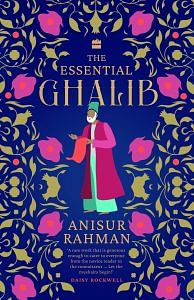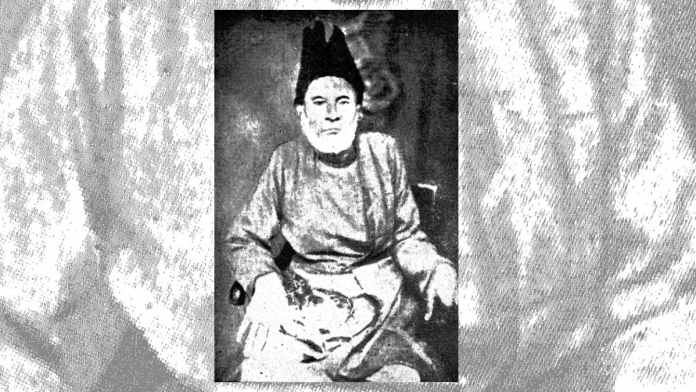Naqsh faryaadii hai kis kii shokhii-i tahriir kaa, kaaghazii hai pairahan har paikar-e tasviir kaa.
Ghalib opens his diivaan with a unique stroke of his genius. The imploring in the first line, followed by an answer in the second line, opens up various avenues of interpretation. The implication here is that the implorer is seeking justice as he has been subjected to oppression. Apart from being an individual, he is also a stock figure —an everyman— in a state of eternal entreaty, insofar as he represents the perpetual human condition marked by suffering. This imploring is being made to God, or to the one in the seat of power on this earth. The implorer thus underlines what we know today as a discourse on the dialectics of power and powerlessness, or the oppressor and the oppressed. Interestingly, the image of the implorer is also like the one that a painter paints on a paper canvas, puts in a frame and hangs on a wall, as a reminder of the eternal human condition. In this much-debated but iconic verse, Ghalib creates a cosmos of meaning relating to the metaphysical meaning of human existence and survival which constitutes the kernel of his poetry at large.
It should now be easy to mark the significance of the deeply implicated questions Ghalib puts frontally: (a) whose caprice, or craft, does the image stand as witness to? (b) why has the creator cast the image in a paper robe, which is essentially ephemeral? (c) is the creator a flippant being to have done so? (d) why is the created one so still and silent in his protest and appeal? and (e) is it the individual or the entire phenomenon, which is subjected to eternal suffering? Answers to all these questions are clearly self-suggestive.
Ghalib was once told to his face that this was a meaningless verse. He then asked a friend in a letter to listen to the ‘meaning of this meaningless verse’ and related it to a custom in Iran where the appellant used to put on a paper robe and appear before the ruler to protest and seek justice. This was similar to carrying a lighted torch in India, or hanging the blood-soaked clothes of the murdered one on a stick in Arabia. This allusion takes us to the heart of the verse and adds to its foundational strength. Far from being meaningless, this verse represents a metaphysical meaning. This is one of the most precise verses of Ghalib where words act like metaphors: naqsh for the picture of suffering, faryaadii for the oppressed ones, shoKHii-i tahriir for the craftiness of scripting, kaaGhazii for ephemerality, pairahan for perishability, and paikar-e tasviir for the suffering human being inside a robe, which together bear the structural and thematic burden of the verse.
Jazba-i be-iKHtiyaar-e shauq dekhaa chaahiye, siina-i shamshiir se baahar hai dam shamshiir kaa.
The passion of genuine lovers for their love is always uncontrollable. An idea as simple as this gets an exceptionally rich poetical configuration with the terribly beautiful image of a shamshiir (scimitar). Ghalib invites us to watch the lover’s ardour and zeal in terms of the sparkling scimitar, which compares well with the sparkling desire of lovers for each other. As the scimitar’s sparkle shows beyond its sheath and sharpness, the verse is enriched with multiple imports with reference to the desire of the lovers. It is in this aspect that the unique beauty of the verse lies.
A master of creating connotations, Ghalib projects several possible meanings for us. He seems to suggest: (a) the scimitar lies breathing as if in the sheath of its own breast, just as the passion of lovers breathes in their breasts (b) just as the scimitar cannot hold its sparkle within its own breast, the lovers too cannot hold their desire within their breasts (c) the lovers’ overwhelming passion is as sparkling as the scimitar itself, and (d) the sparkling edge of the scimitar and the lovers’ heart, brimming with desire, are two images of the same beauty and they reflect upon each other.
Two expressions, in particular, hold the key to this verse. While siina-i shamshiir (cutting edge of scimitar) implies the shining breast of the scimitar, dam (sparkle/breath) suggests the breath of life. Both these expressions are metaphorically charged and are richly suggestive in the larger context of the verse. Importantly enough, the second line far outweighs the first line in its impact, as the first one is only an inviting statement, while the second one flows out of it with its own resilience to complete the web of meaning. The verse clearly works through the device of establishing a reason to express a reason which adds a magical quality to it. We may refer to another verse of Ghalib here to mark how differently he plays upon the sparkling beauty of a scimitar here: ‘ishrat-eqatl-gahe ahl-e tamannaa mat puuchh / ‘iid-e nazzara hai shamshiir kaa ‘uryaa.n honaa. If we consider the two verses together, we may mark how a poet’s imagination soars to seek poetic strength in different verses with different images.
 This excerpt from ‘The Essential Ghalib’ by Anisur Rahman has been published with permission from HarperCollins.
This excerpt from ‘The Essential Ghalib’ by Anisur Rahman has been published with permission from HarperCollins.






